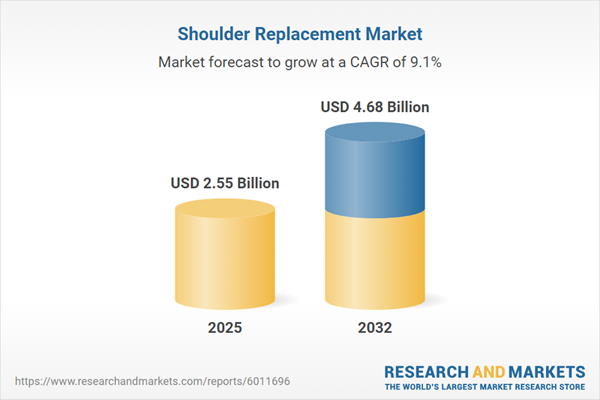Speak directly to the analyst to clarify any post sales queries you may have.
The global shoulder replacement market is evolving, catalyzed by technological advancements and shifting models of care. Senior decision-makers are recalibrating their strategies to secure growth opportunities and mitigate risks in this competitive landscape.
Market Snapshot: Global Growth in the Shoulder Replacement Market
Accelerated by the adoption of innovative orthopedic technology, the global shoulder replacement market continues to expand and diversify. Key contributors to this momentum include increased demand for upper extremity interventions among aging populations, evolving patient expectations, and the spread of minimally invasive surgical procedures. As health systems invest in specialist facilities and prioritize improvements in care quality, market participants are intensifying their focus on device engineering, patient-centered protocols, and adaptive strategies that reflect local clinical practices. The sector’s development is further complemented by collaborations between providers, payors, and manufacturers, supporting progressive growth and responsive innovation worldwide.
Scope & Segmentation
- Product Types: Anatomic shoulder implants, available in both stemless and stemmed configurations, surface replacement devices, and reverse shoulder systems support a full range of clinical needs, from targeted repairs to complex reconstructions.
- Applications: These devices address a broad array of clinical scenarios, including avascular necrosis, traumatic bone injuries, various arthritis types, rheumatoid conditions, and rotator cuff repairs, enabling clinicians to tailor care for optimal patient results.
- End Users: The main points of care—ambulatory surgery centers, major hospital networks, and orthopedic specialty clinics—require customized device procurement and implementation solutions for both inpatient and outpatient settings.
- Material Types: Choices between cemented and cementless fixation offer surgeons flexibility to suit individual patient anatomy and biomechanical demands, promoting improved integration and procedural outcomes.
- Regional Coverage: North America is at the forefront of new technology adoption and procedural volume, while Asia-Pacific demonstrates rapid market development and production capacity. In Europe, Latin America, the Middle East, and Africa, tailored device strategies are enhancing access to advanced interventions in alignment with distinct regulatory and care system dynamics.
- Key Companies: Industry leaders such as DePuy Synthes, Zimmer Biomet, Stryker, Exactech, Enovis, Smith & Nephew, MicroPort Scientific, and Wright Medical Group underscore the market through targeted expansion and investment in local and global projects.
Key Takeaways: Strategic Insights for Senior Decision-Makers
- Digital surgical planning combined with patient-specific instrumentation is streamlining operating room efficiency and enabling consistent outcomes in both routine and complex shoulder procedures.
- Aligning business models with value-driven reimbursement structures is fostering improvements in orthopedic team workflows, care quality, and risk mitigation across the continuum of care.
- Remote care tools—including digital preoperative education and telemonitoring—are facilitating sustained patient engagement, enhancing compliance, and reducing perioperative complications for orthopedic providers.
- Modular implant systems and flexible surgical techniques allow healthcare organizations of varying scale to expand service delivery in response to evolving demand and resource constraints.
- Collaborations between technology developers and domestic manufacturers support compliance, workforce training, and the adoption of advanced protocols, especially within emerging markets facing regulatory and infrastructure transitions.
Tariff Impact: U.S. Policy and Global Supply Chains
Recent U.S. tariffs on orthopedic devices have intensified the market’s focus on domestic manufacturing capabilities and the resilience of global supply chains. Procurement specialists are employing diversified sourcing strategies and enhancing supplier collaboration to buffer against device shortages and regulatory disruptions, maintaining consistent access to essential technologies.
Methodology & Data Sources
This market assessment draws on direct interviews with orthopedic surgeons, device engineers, and supply chain stakeholders. Findings are substantiated by peer-reviewed literature, global registry input, supplier disclosures, and official regulatory documentation for a robust and transparent market outlook.
Why This Report Matters
- Provides senior executives with actionable insights to anticipate technology trends and prioritize responsive investment in developing orthopedic capabilities.
- Identifies approaches to improve operational performance and navigate compliance demands in a dynamically shifting orthopedic marketplace.
- Supports strategic supply chain planning, ensuring quality, reliability, and patient-centered delivery throughout the orthopedic sector.
Conclusion
Senior leaders can leverage this comprehensive analysis to drive innovation, shape strategic direction, and remain agile as the global orthopedic market continues to evolve.
Additional Product Information:
- Purchase of this report includes 1 year online access with quarterly updates.
- This report can be updated on request. Please contact our Customer Experience team using the Ask a Question widget on our website.
Table of Contents
3. Executive Summary
4. Market Overview
7. Cumulative Impact of Artificial Intelligence 2025
Companies Mentioned
The companies profiled in this Shoulder Replacement market report include:- DePuy Synthes, Inc.
- Zimmer Biomet Holdings, Inc.
- Stryker Corporation
- Exactech, Inc.
- Enovis Corporation
- Smith & Nephew PLC
- MicroPort Scientific Corporation
- Wright Medical Group N.V.
Table Information
| Report Attribute | Details |
|---|---|
| No. of Pages | 193 |
| Published | November 2025 |
| Forecast Period | 2025 - 2032 |
| Estimated Market Value ( USD | $ 2.55 Billion |
| Forecasted Market Value ( USD | $ 4.68 Billion |
| Compound Annual Growth Rate | 9.0% |
| Regions Covered | Global |
| No. of Companies Mentioned | 9 |









